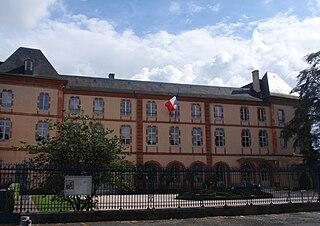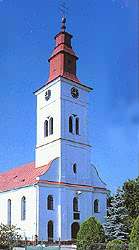| Luby-Betmont | ||
|---|---|---|
| Commune | ||
| ||
| Coordinates: 43°17′48″N0°17′36″E / 43.2967°N 0.2933°E Coordinates: 43°17′48″N0°17′36″E / 43.2967°N 0.2933°E | ||
| Country | France | |
| Region | Occitanie | |
| Department | Hautes-Pyrénées | |
| Arrondissement | Tarbes | |
| Canton | Les Coteaux | |
| Intercommunality | Communauté de communes du Pays de Trie | |
| Area1 | 7.16 km2 (2.76 sq mi) | |
| Population (1999)2 | 121 | |
| • Density | 17/km2 (44/sq mi) | |
| Time zone | CET (UTC+1) | |
| • Summer (DST) | CEST (UTC+2) | |
| INSEE/Postal code | 65289 /65220 | |
| Elevation | 252–385 m (827–1,263 ft) (avg. 225 m or 738 ft) | |
1 French Land Register data, which excludes lakes, ponds, glaciers > 1 km2 (0.386 sq mi or 247 acres) and river estuaries. 2 Population without double counting : residents of multiple communes (e.g., students and military personnel) only counted once. | ||
Luby-Betmont is a commune in the Hautes-Pyrénées department in south-western France.
The commune is a level of administrative division in the French Republic. French communes are analogous to civil townships and incorporated municipalities in the United States and Canada, Gemeinden in Germany, comuni in Italy or ayuntamiento in Spain. The United Kingdom has no exact equivalent, as communes resemble districts in urban areas, but are closer to parishes in rural areas where districts are much larger. Communes are based on historical geographic communities or villages and are vested with significant powers to manage the populations and land of the geographic area covered. The communes are the fourth-level administrative divisions of France.

Hautes-Pyrénées is a department in southwestern France. It is part of the Occitanie region.
In the administrative divisions of France, the department is one of the three levels of government below the national level, between the administrative regions and the commune. Ninety-six departments are in metropolitan France, and five are overseas departments, which are also classified as regions. Departments are further subdivided into 334 arrondissements, themselves divided into cantons; the last two have no autonomy, and are used for the organisation of police, fire departments, and sometimes, elections.
The village church has the curious feature of chiming the hours twice. The reason for this is uncertain, although it may have been to allow workers in the fields a second chance to confirm the hour in order to be sure when to return to the farms for meals. The exceptions to the double chiming are at 7am and noon, when a more complex bell ringing takes place prior to the masses.
The village sits on the D11, just south of the junction with the D632 and forms the head of the annual Course de Cote ( hill climb) which starts at the neighbouring village of Osmets. The village church has the common French rural feature of chiming the hours twice. The reason for this is unclear, but generally accepted as being a means for agricultural workers to check the time accurately in order to be sure when to return to the village or home for meals. The exception to the double chiming are at 7am and noon, when a more complex bell ringing takes place prior to mass.





















